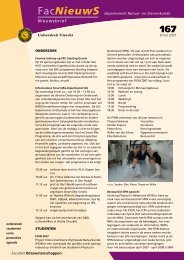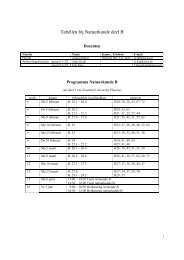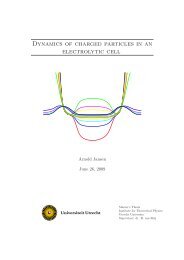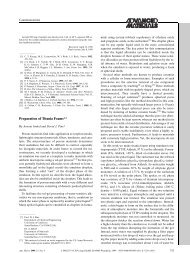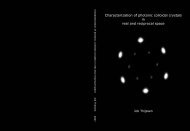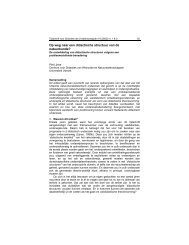Sedimentation Equilibrium of Mixtures of Charged Colloids
Sedimentation Equilibrium of Mixtures of Charged Colloids
Sedimentation Equilibrium of Mixtures of Charged Colloids
Create successful ePaper yourself
Turn your PDF publications into a flip-book with our unique Google optimized e-Paper software.
with ν λ = ν 0 +λw, the free energy functional can be written, after integration<strong>of</strong> equation (2.25),F [ρ] = F 0 [ρ] + 1 2∫ 10dλdrdr ′ ρ (2)λ (r, r′ )w(r, r ′ ), (2.26)where F 0 [ρ] is the free energy functional <strong>of</strong> the reference system with ν = ν 0 .Substitution <strong>of</strong> the two particle density by the pair correlation functionh (2) (r, r ′ ) = ρ(2) (r, r ′ )ρ(r)ρ(r ′ ) − 1 (2.27)splits the free energy functional into three partsF [ρ] = F 0 [ρ] + 1 ∫ 1 ∫ ∫dλ dr dr ′ ρ(r)w(r, r ′ )ρ(r ′ )2 0+ 1 ∫ 1 ∫ ∫dλ dr dr ′ h (2)λ2(r, r′ )ρ(r)w(r, r ′ )ρ(r ′ ), (2.28)0where the last part (2.28) is the correlation term <strong>of</strong> the free energy. Themean field approximation is made by neglecting this correlation term.Stated less formally and taking the electrostatic potential as an example:by using the MFA, one considers the long-range pair potential as a selfconsistentexternal field for which∫φ(r) = dr ′ Q(r ′ )|r − r ′ | , (2.29)where Q(r) is the total charge density.VThe local density approximation , also known as LDA, is based on theassumption that macroscopic thermodynamics applies locally. The intrinsicHelmholtz free energy may then be written as∫F [ρ] = drf(ρ(r)) (2.30)where the free energy density f(ρ) satisfiesVF (N, V, T )f(ρ) = , (2.31)Vwith ρ = N/V the homogeneous density. For systems with long-range interactions(like Coulomb interactions), the LDA cannot be expected to hold.For example, hydrostatic equilibrium (eq.density approximation.B.16) is derived using a local9



